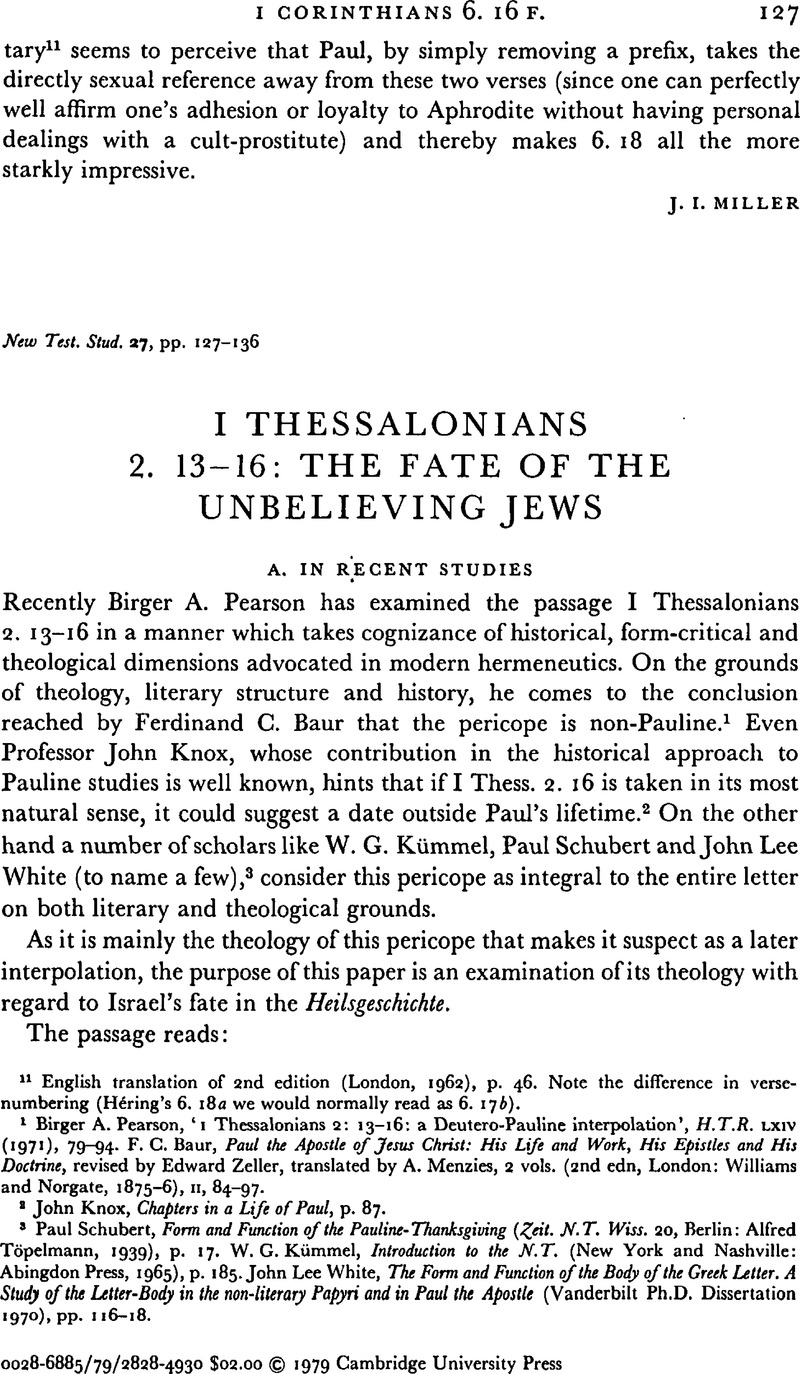Published online by Cambridge University Press: 05 February 2009

1 Pearson, Birger A., ‘I Thessalonians 2: 13–16: a Deutero-Pauline interpolation,’ H.T.R. 64 (1971), 79–94Google Scholar. Baur, F. C., Paul the Apostle of Jesus Christ: His Life and Work, His Epistles and His Doctrine, revised by Edward, Zeller, translated by Menzies, A., 2 vols. (2nd edn, London: Williams and Norgate, 1875–1876), II, 84–97.Google Scholar
2 Knox, John, Chapters in a Life of Paul, p. 87.Google Scholar
3 Schubert, Paul, Form and Function of the Pauline-Thanksgiving (Zeit. N. T. Wiss. 20, Berlin: Alfred Töpelmann, 1939), p. 17Google Scholar. Kümmel, W. G., Introduction to the N.T. (New York and Nashville: Abingdon Press, 1965), p. 185Google Scholar. John, Lee White, The Form and Function of the Body of the Greek Letter. A Study of the Letter-Body in the non-literary Papyri and in Paul the Apostle (Vanderbilt Ph.D. Dissertation 1970), pp. 116–18.Google Scholar
4 Baur, op. cit. p. 88.
5 Extent of interpolation: (a) 2. 16c only, so Albrecht Ritschl, Spitta, Pfleiderer, Teichmann, and Moffatt, J., who cites the foregoing scholars, Introduction to the Literature of the New Testament (3rd ednEdinburgh: T. & T. Clark, 1927), p. 73Google Scholar; so also Bailey, J., Interpreter's Bible, 11, 280Google Scholar. (b) vv. 15–16; so P. Schmiedel, in Pearson, loc. cit. p. 80; Schmithals, Paul and the Gnostics, pp. 127, 180. (c), vv. 14–16. So Holtmann cited by Frame, J. E., Thessalonians, p. 109.Google Scholar
6 Brandon, S. G. F., The Fall of Jerusalem, pp. 92–3Google Scholar, says that the invectives against the Jews reflect the spirit and language of Christians immediately before and following the destruction of Jerusalem in A.D. 70. For Schmiedel's view see Schmithals, , Paul and the Gnostics, p. 180.Google Scholar
7 See Johannes Munck, Paul and the Salvation of Mankind, pp. 286–8 in disagreement with Karl, Holl, ‘Der Kirchenbegriff des Paulus in seinem Verhältnis zu der Urgemeinde,’ Gesammelte Aufsätze zur Kirchengeschichte 11, n.d., in MunckGoogle Scholar, Ibid. pp. 44–67. Also Hurd, J. C., ‘The collection,’ J.B.L. 86 (1967), 346–7Google Scholar; Keith, Nickle, The Collection: a Study in St Paul's Strategy (London: SCM, 1966), p. 74.Google Scholar
8 See Hurd, John Jr, ‘The sequence of Paul's letters,’ Can. J. Theol. 14, 3 (1968), 159–200.Google Scholar
9 Josephus, , Jewish Antiquities, XX. V. 1.Google Scholar
10 E.g.Pearson, loc. cit. pp. 85–7.
11 Frame, J. E. (Thessalonians, p. 114Google Scholar) suggests that έϕθασεν is employed proleptically, as is natural in prophetic utterances.
12 von Dobschütz, E., Die Thesslonicher-Briefe – ‘Kritisch-exegetischer Kommentar’ (7th ednGöttingen: Vandenhoeck & Ruprecht, 1909), p. 115Google Scholar, cited by Munck, , Christ and Israel, p. 62Google Scholar; Gaston, No Stone on Another.
13 ⊓уℶ in Brown-Driver-Briggs, English-Hebrew Lexicon, p. 664; Ackroyd, P. R., εΙς τέλος = ⊓уℶ, Exp. T. 70 (1969), 126Google Scholar; εΙς and τέλος in Arndt and Gingrich, , Greek-English Lexicon, pp. 228 and 819.Google Scholar
14 Pearson, loc. cit. pp. 85–6.
15 Oscar, Cullmann, ‘Le Caractère eschatologique du devoir missionnaire et de la conscience apostolique de S. Paul,’ Revue d' Histoire et de Philosophie Religieuses, 16 (1936), 210–45Google Scholar. In German in Vorträge und Aufsätze 1925–1962 (Tübingen and Zürich, 1966), pp. 305–36.Google Scholar
16 έϕθακεν, 3rd person sing. Perf. Indicative Active of ϕθάνω, is supported by B and D.
17 Johannes, Munck, Christ and Israel. An Interpretation of Romans 9–11 (Philadelphia: Fortress Press, 1967), pp. 63–4, 89–99.Google Scholar
18 John Hurd, Jr, op. cit. p. 198; see also Buck, Charles Jr, ‘The Collection for the saints,’ H.T.R. 43, 1 (1950), 1–29.Google Scholar
19 Stauffer, Ethelbert, New Testament Theology, translated by Marsh, John (London: SCM, 1955), pp. 190–1.Google Scholar
20 Schoeps, Hans-Joachim, Paul: the Theology of the Apostle in the Light of Jewish Religious History (London: Lutterworth Press, 1961), pp. 260–2Google Scholar. He and some modern scholars like Pearson so over-emphasize the creativeness of Paul that he becomes a total innovator.
21 Dodd, C. H., The Apostolic Preaching, pp. 71, 204–5.Google Scholar
22 Bultmann, Rudolf, Theology of the New Testament 1, 293.Google Scholar
23 Schoeps (Paul, pp. 225–9) suggests that Paul came from the circle of Hillel and Gamaliel who were favourable to Gentile mission; for them the conversion of the gerim was a necessary step for the coming of the Kingdom of God.
24 See Davies, W. D., Paul and Rabbinic Judaism, pp. 110–22.Google Scholar
25 Dodd, C. H., New Testament Studies, pp. 72–4, 118–19.Google Scholar
26 Rom. 3. 22; 9–12; Gal. 3. 28; Col. 3. 2. For fuller discussion of the near expectation of the Parousia in the early church see Moore, A. L., The Parousia in the New Testament, esp. ch. 19, pp. 160 ff.Google Scholar
27 Rom. 9. 25–33. God's merciful election is purposed to be a means of reaching out to those who are without the light of God's love and righteousness. So Paul considers his mission among the Gentiles as God's means of saving the Jews who are in the darkness of unenlightened zeal (Rom. 10. 2).
28 Gaston, L., No Stone, p. 457.Google Scholar
29 Jeremias, J., The Parables of Jesus, ET by Hooke, S. H. (London: SCM, 1963), pp. 224–6.Google Scholar
30 Dodd, C. H., ‘The Mind of Paul. 11,’ New Testament Studies, pp. 122–4.Google Scholar
31 Cullmann, Oscar, ‘Eschatology and Mission in the New Testament’, The Background of the New Testament and its Eschatology. Essays in Honour of C. H. Dodd, ed. by Davies, W. D. and Daube, D. (Cambridge: CUP, 1956), pp. 409–21Google Scholar. See Vorträge und Aufsätze, pp. 348–60.
32 See Hyldahl, N., ‘Jesus og Jøderne ifølge 1 Thess. 2, 14–16’ (‘Jesus and the Jews according to I Thess. 2. 14–16’), Svensk Exeg. Års. 37–38 (1972–1973), 238–54Google Scholar. He argues unpersuasively that I Thess. 2. 16 is not in conflict with Rom. 11 in that the later passage teaches that only a miracle can save Israel.